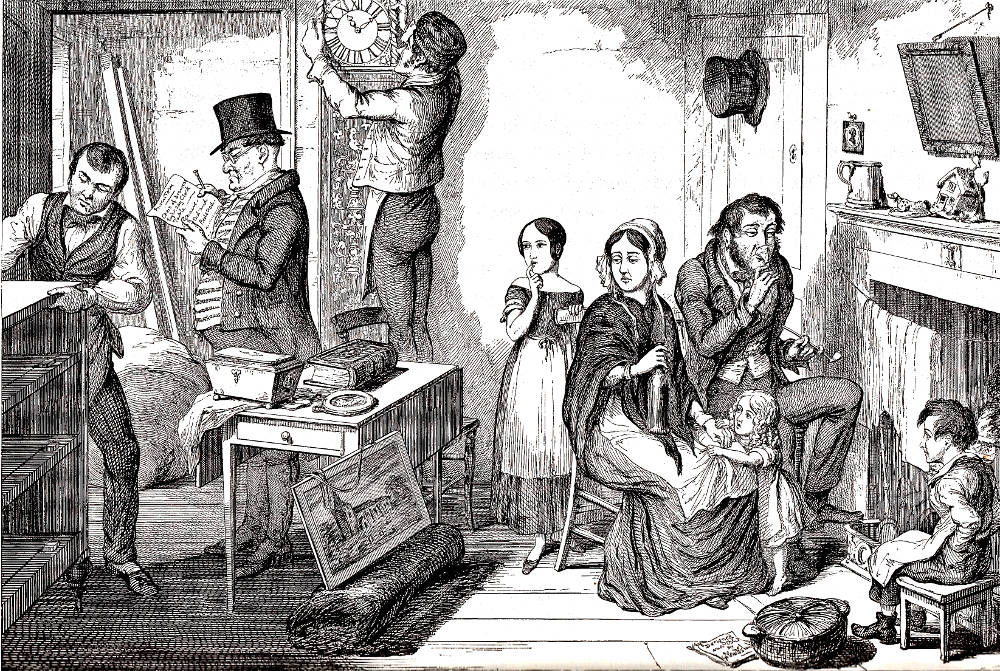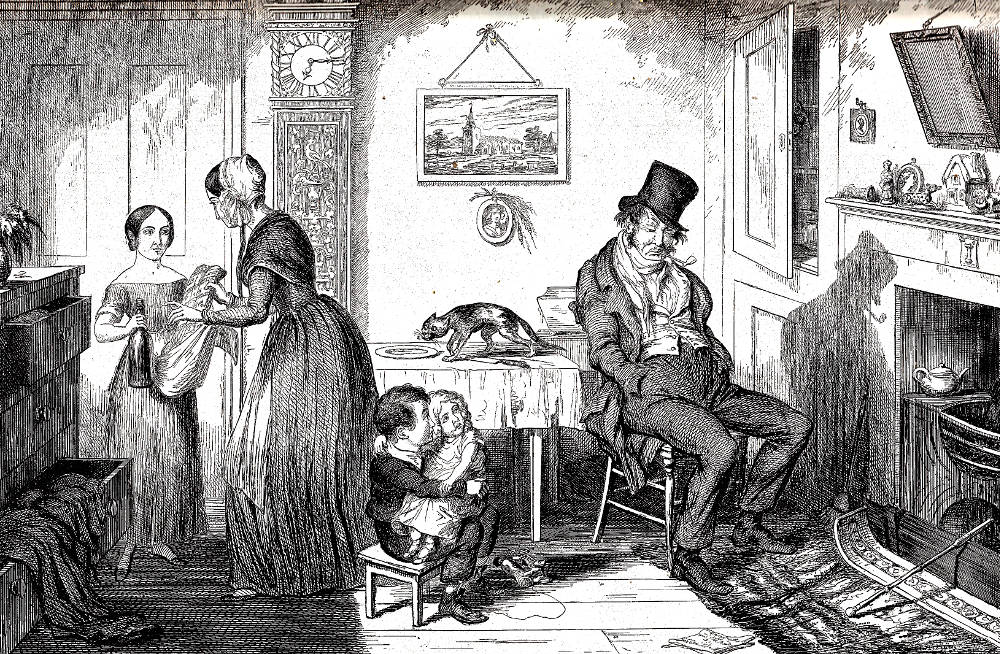
An Execution Sweeps Off the Greater Part of Their Furniture: They Comfort Themselves with the Bottle — George Cruikshank. 1847. Third illustration in The Bottle. Folio page: 46 x 36 cm (24 inches by 14.5 inches), framed. The etchings were reproduced by glyphography, "enabling the publisher [David Bogue, London] to sell the entire series for one shilling" (Vogler, p. 159). [Click on the image to enlarge it.]
Scanned image and text by Philip V. Allingham. [You may use this image without prior permission for any scholarly or educational purpose as long as you (1) credit the person who scanned the image and (2) link your document to this URL in a web document or cite the Victorian Web in a print one.]
Analysis
Drunkenness and unemployment lead to debts that bring legal action in the form of an "execution" against the remaining family belongings. Familiar objects are being checked against an inventory prior to removal, as the family huddles disconsolately on the right. The parents seated by the hearth look most dispirited. The gin-drinking husband now appears more dissolute than before. With keen regret, the wife regards for the last time their household possessions. The sad event occurring in this design is represented emblematically by the now broken china house on the mantel. The angst of the three children is painfully evident. — Richard A. Vogler, p. 160.
As W. H. Chesson remarks contemptuously of this scene in his 1908 analysis, "Had an artist and not a missionary composed plate 3, we might have been spared the indecency of a bottle in Lucy's lap when the furniture is distrained to pay the bottle's debt" (56); and yet, despite the overt moralizing, the composition is not without artistic merit. The bailiff's men are active, and, if not insensitive, at least oblivious to the passive group huddled around the fireplace, which once again has a coal fire. The painting of the church, a cameo portrait, a carpet, the tea-chest, the family Bible, a writing desk, the grandfather clock, and the chest of drawers are all about to carried off. The inventory held by the no-nonsense bailiff (a societal figure whom Cruikshank had already drawn as a comic character in 1836 for Dickens's Sketches by Boz in The Broker's Man) includes a chest of drawers, clock, and table. The other embedded text, the book near the work basket, once again reads, "Designed and Etched by George Cruikshank." "There are Hogarthian touches, developing the story throughout the series. In this plate the china cottage upon the mantelpiece is broken, and the husband's battered hat upon a peg is the only ornament to the bare walls" (Blanchard Jerrold, The Life of George Cruikshank. In Epochs, vol. 2, p. 250). The hat, a little worse for wear and not entirely respectable, hangs above the father's head, drawing the viewer's attention to the closed cupboard. The disreputable nature of the hat is reinforced by a ragged cloth (a dish-towel or a shirt) that hangs drying before the fire. The adolescent daughter in anxiety gazes at the workmen, her finger to her lip. Though young, the children seem more acutely aware of what is about to happen than the mother, who seems stunned by the turn of events. Utterly lost in his stupor of liquor and tobacco is the man of the house, whose form seems to have shrunk since Plates I and II. On the mantel only three pieces of the original bric-a-brac have survived: a tankard, the damaged china cottage (which is apparently a pipe-holder), and a canine figurine. The total absence of food and dinnerware suggests that the family are no longer enjoying regular meals. And where the picture of the country church had hung Cruikshank highlights the bare wall, and places a ragged crack running half-way through it to suggest the dissolution of the home. One senses that Cruikshank's position was informed by personal experience, as Jane Rabb Cohen suggests in her chapter on the artist in Charles Dickens and His Original Illustrators.
Biographical Significance
As a young man, Cruikshank had watched his own father drink himself into a premature grave. And he long recalled the besotted James Gillray, one of his graphic mentors, ranting before he died: "You are not Cruikshank but Addison, my name is not Gillray but Reubens." During the past decade, his brother Robert had been drinking heavily and seemed to be following the same ruinous path. These specters seemed to remind Cruikshank not only of the evils of drink but also of the happy period when his own career had seemed so promising. — Jane Rabb Cohen, p. 33.
Thus, the fate of the father as inebriate, madman, and murderer in the narrative-pictorial series (and of the three children in the 1848 sequel) reflects Cruikshank's recollections of his own father and his anxieties about his brother, Robert, and perhaps even about himself. Rejecting Dickensian "moderation" as too conducive to a former alcoholic's backsliding, Cruikshank took the pledge. Having committed himself the stoney path of complete abstinence, Cruikshank found a strange continuity in his life with respect to alcohol: "Teetotalism, then, provided the artist's life and art with a peculiar kind of continuity as well as meaning and purpose" (Cohen, 33).
Dramatic Adaptations
In October 1847, eight dramatic adaptations in the medium of domestic melodrama were mounted by various minor theatres in London. In the chief of these, Tom Taylor's The Bottle: A Melodrama in Two Acts, Based on the Illustrations by George Cruikshank, the cast is filled out with stock theatrical figures, and considerable dialogue given the wife, who is not entirely patient, silent, and long-suffering. Robertson Davies found her incessant nagging and moralising a distraction:
The play is decidedly not of the same order of artistic achievement as the pictures [which served as the basis for the play's eight tableaux "under the Personal Superintendence of Mr. George Cruikshank," as the playbill announced]; the wearisomely didactic wife of the drunkard, his spiritless children, the snuffling, lacklustre quality of his downfall, and his subsequent death — 'What mist is that which is falling? What bubbling is this next my heart?' — have not the Cruikshank incisiveness and stimulating grotesquerie. But the evidence is that [Taylor's] play gave much satisfaction. ["Playwrights and Plays, 1840-1850," 237]
Taylor's melodrama — or, more properly, a "Temperance Drama," a subgenre invented in 1828 by Douglas Jerrold in Fifteen Years of a Drunkard's Life — gives the father a specific name and job, and adds gambling to his list of self-made problems, as Michael R. Booth, a specialist in nineteenth-century drama, has noted:
Through a fatal addiction to the bottle, Thornley, a factory worker, loses his job, gambles away all his money, has his furniture seized, is turned out of his house, and begs in the street. When his youngest child dies of starvation, he drinks stupidly by the coffin. He apprentices his other son to criminals for drink money, kills his wife in a drunken rage with "the Instrument of all their Grief," and ends chained in a madhouse. [Booth, p. 207]
Other productions in London's October 1847 mania for plays from the Cruikshank portfolio were The Royal Pavilion's The Bottle (10 Oct.), The Standard's Our Bottle; or, A Drunkard's Progress (18 Oct.), The Britannia Saloon's The Bottle Bane; or, A Drunkard's Life and Fate by G. D. Pitt (20 Oct.), The Albert Saloon's The Bottle and the Glass; or, The Drunkard's Progress, A Drama of Every Day Life by C. Z. Barnett (25 Oct.). The story lacks both situational intensity and character development in these adaptations because the principals are mere types rather than individuals; in the Cruikshank original, "only one or two of the minor characters in The Bottle have physiognomic character — e. g., the sour Pickwickian bailiff in Plate III" (Meisel, 125). The necessary melodramatic "elaboration" of plot and character to expand the eight plates into two acts meant that the experience of watching one of the play versions was entirely different from the act of studying Cruikshank's plates without dialogue, movement, and stage business. As Martin Meisel in his seventh chapter, "From Hogarth to Cruikshank," serial prints transform a picture into a play,
The art of the serial print-maker was an art of vivid compression, of putting the stages of an action into readable visual situations; the art of the dramatist added to that requirement the art of time-filling elaboration. [p. 125]

Above: Cruikshank's "happy home" has been shattered by the arrival of the gin bottle, whose consequences rapidly become apparent in the second of the illustrations in the 1847 sequence, He Is Discharged from His Employment for Drunkenness: They Pawn Their Clothes to Supply the Bottle. [Click on image to enlarge it.]
Related Material
- George Cruikshank and Charles Dickens
- The Gin-Shop
- "Great is thy power, O Gin" — Reynold's sermon on the harm it does to the poor
- London Gin Shops
- "Frauds on the Fairies" (1 October 1853)
- Temperance, Teetotalism, and Addiction in the Nineteenth Century
- Addiction in the Nineteenth Century
- Drunkedness and the ease of obtaining alcohol
- Alcohol and Alcoholism in Victorian England
- The Band of Hope Review
- Charles Dickens and Two Kinds of Punch, 1. The Beverage
Bibliography
Booth, Michael R. "The Drunkard's Progress: Nineteenth-Century Temperance Drama." The Dalhousie Review, 44.2 (1964): 205–12.
Chesson, Wilfred Hugh. George Cruikshank. The Popular Library of Art. London: Duckworth, 1908.
Cohen, Jane Rabb. Part One, "Dickens and His Early Illustrators: 1. George Cruikshank. Charles Dickens and His Original Illustrators. Columbus: Ohio University Press, 1980. Pp. 15-38.
Davies, Robertson. "Playwrights and Plays, 1840-1850." The Revels History of Drama in English, Volume VI: 1750-1880. Ed. Clifford Leech and T. W. Craik. London: Methuen, 1975. Pp. 231-240.
James, Louis. "An Artist in Time: George Cruikshank in Three Eras." George Cruikshank: A Revaluation. Ed. Robert L. Patten. Princeton: Princeton U. P., 1974, rev., 1992. Pp. 156-187.
Jerrold, Blanchard. "Epoch Two, 1848-1878. Chapter 2, The Bottle." The Life of George Cruikshank. In Two Epochs. Illustrated by George Cruikshank. 2 vols. London: Chatto and Windus, 1882. Vol. 2, Pp. 248-255.
Kitton, Frederic G. "George Cruikshank." Dickens and His Illustrators. London: Chapman & Hall, 1899. Pp. 1-28.
McLean, Ruari. George Cruikshank: His Life and Work as a Book Illustrator. English Masters of Black-and-White. London: Art and Technics, 1948.
Meisel, Martin. Chapter 7, "From Hogarth to Cruikshank." Realizations: Narrative, Pictorial, and Theatrical Arts in Nineteenth-Century England. Princeton: Princeton U. P., 1989. Pp. 97-141.
Mellby, Julie L. "More than 100,000 copies sold in the first few days." Graphic Arts: Exhibitions, acquisitions, and other highlights from the Graphic Arts Collection, Princeton University Library. Web. 13 April 2011. https://blogs.princeton.edu/graphicarts/2011/04/the_bottle.html
Vogler, Richard A. Graphic Works of George Cruikshank. Dover Pictorial Archive Series. New York: Dover, 1979.
Last modified 7 August 2017